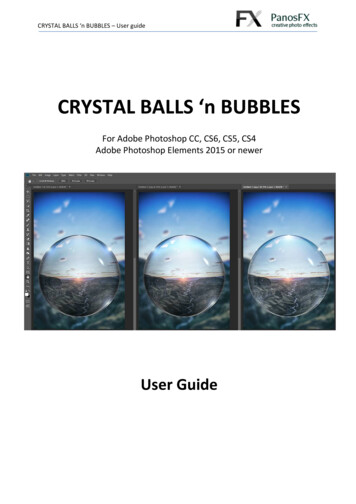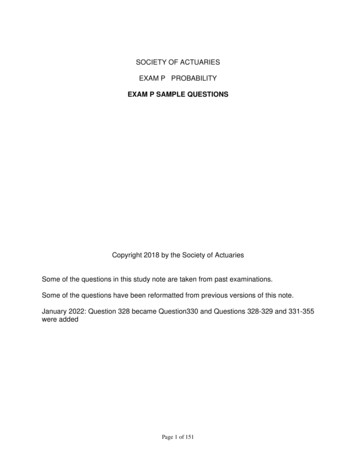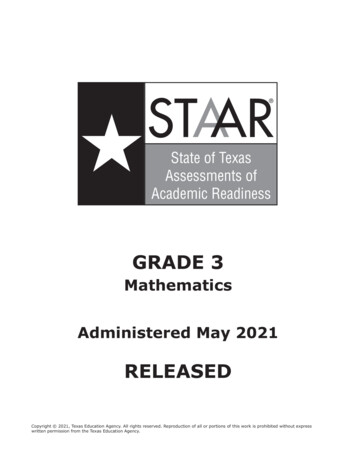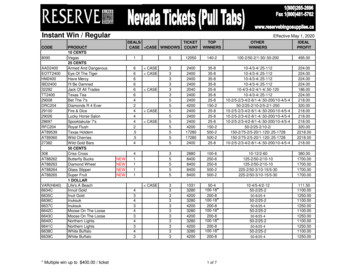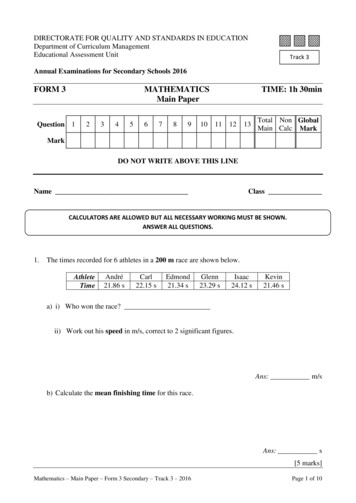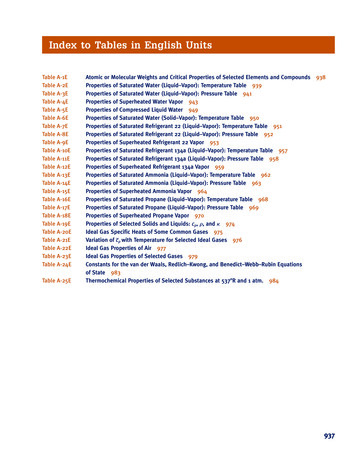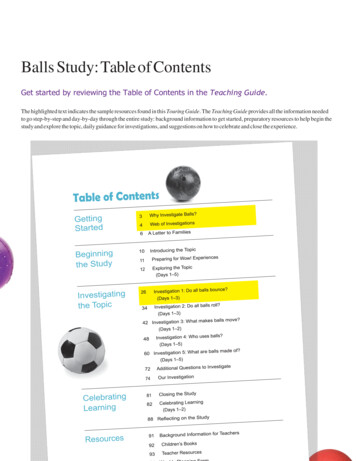
Transcription
Balls Study: Table of ContentsGet started by reviewing the Table of Contents in the Teaching Guide.The highlighted text indicates the sample resources found in this Touring Guide. The Teaching Guide provides all the information neededto go step-by-step and day-by-day through the entire study: background information to get started, preparatory resources to help begin thestudy and explore the topic, daily guidance for investigations, and suggestions on how to celebrate and close the experience.
Why Investigate Balls?At the start of every study is a “Why Investigate.?” section that provides context.All the study topics in The Creative Curriculum for Preschool—such as balls, trees, and buildings—are topics that already interestchildren and are familiar and fascinating to them. This is one of the major distinguishing features of The Creative Curriculum forPreschool: The study topics are relevant to—rather than removed from—the everyday lives of children. The studies involve childrenin hands-on exploration, problem solving, and communication.
Web of InvestigationsA“Web of Investigations”is also included at thebeginning of every study.This section introduces the concept ofan idea web, a way to think about theimportant ideas related to a topic and theareas that children might explore. Eachstudy includes a preliminary idea web thathas extra space for teachers to record theirown ideas.In this way, teachers can adapt the TeachingGuide to the resources that are available inthe community and the particular learningthey want to emphasize.
Sample PagesPutting It Into PracticeHere’s an example of oneteacher’s idea web.Notice how she begins with the studytopic—balls—and branches out to identifymany areas of exploration that interest thechildren in her classroom. From the ideaweb, this teacher and her class are able toidentify what they already know aboutballs. Then they identify the questions theywant to answer.
At a Glance, Investigation 1Next Step:Plan and PrepareAT A GLANCEThe “At a Glance” pages that precedeevery exploration and investigationhelp teachers with planning. Theyprovide a bird’s-eye view of what thenext few days will look like.Investigation 1Do all balls bounce?Vocabulary—English: circumference, length, shorter, longer, sphereVocabulary—English: neighborhoodDay 1The number of days the teacher seeson the “At a Glance” chart will varyaccording to the question(s) beinginvestigated and how involvedchildren become.Interest AreasDay 2Toys and Games: sorting trays; aToys and Games: sorting trays; avariety of small ballsvariety of small balls and circlesTechnology: eBook version of The ThreeBilly Goats GruffQuestion of the DayDo you think all balls bounce?Is your head bigger or smaller than this baLarge GroupMovement: The Imaginary BallMovement: The Imaginary Ballown questions, thesepreselected questionsactively involve childrenDiscussion and Shared Writing: Which BallsDiscussion and Shared Writing:Will Bounce?Height and BouncinessMaterials: Mighty Minutes 41, “The ImaginaryMaterials: Mighty Minutes 15, “Say It,in the topic they arestudying. Children exploreBall”; ball collection; numeral cards; digitalcamera; Play BallShow It”; ball collectionQuestions for Explorationor Investigation—In addition to children’sthem by engaging inhands-on experiencesthat enable them topractice importantinvestigatory skills.Read-AloudSmall GroupQuestion of the Day—Option 2: Rhyming Zooa family member, childrenanswer a question relatedIntentional Teaching Card LL14, “Did You EverSee ?”; pictures of familiar animals; audiorecorderto something plannedfor that day.Mighty Minutes Materials—The“At a Glance” chart showsall the materials andbooks the teacher needsto gather for each day ofthe investigation.Children’s Literature—During each study, theCollection. The nonfictiontitles relate closely to thestudy topic.Option 1: Rhymes With BallIntentional Teaching Card LL10, “Rhyming Chart”;poem or song with rhyming words; prop thatillustrates poem or songAs part of the morningarrival routine and withhelp from the teacher orteacher uses both fictionand nonfiction books fromthe Teaching Strategies Children’s BookThe Three Billy Goats GruffBook Discussion Card 06 (first read-aloud)2626Mighty Minutes 30, “Bounce, Bounce, Bounce”BounceOption 1: The Long and Short of ItIntentional Teaching Card M25, “TheLong and Short of It”; ribbons ofequal width, cut into different lengthsOption 2: How Big Around?Intentional Teaching Card M62,“How Big Around?”; a variety ofcircular objects; ball of yarn or string;scissorsMighty Minutes 33, “Thumbs Up”; twoitems with the same initial sound
Sample PagesSpanish: circunferencia, longitud, más corto, más largo, esferaSpanish: vecindarioDay 3Toys and Games: add spheres andircles to sortechnology: eBook version of The ThreeBilly Goats GruffDo heavy balls bounce?Song: Clap a Friend’s NameDiscussion and Shared Writing: Weight andBouncinessMaterials: Mighty Minutes 40, “Clap ariend’s Name”; ball collectionThe Three Billy Goats GruffBook Discussion Card 06 (second readloud)Option 1: Letters, Letters, LettersMake Time for Outdoor ExperiencesOutdoor Experiences—These activities either relateBouncing Ballsto the study topic or presentan intentional opportunityfor promoting children’sgross motor skills. Test balls outside to see which ballsbounce the highest. Invite the childrento make predictions and test them. Invite the children to test how ballsbounce on different surfaces, e.g., rocks,sand, grass, and concrete.Family Partnerships—This section offerssuggestions for involvingchildren’s families inthe program. If possible, have children test the ballsby dropping them from variousheights, e.g., slide, steps, and climber.Physical Fun Use Intentional Teaching Card P05,“Throw Hard, Throw Far,” and follow theguidance on the card.WOW! Experiences—(not shown on this page)Each study suggests specialevents that can enhancechildren’s experiences, suchas having visitors in theFamily Partnerships Send home a note to familiesencouraging them to talk with theirchildren about their favorite childhoodball games.classroom, going on sitevisits, or engaging incelebrations of learning.ntentional Teaching Card LL07, “Letters,Letters, Letters”; alphabet rubber stamps;olored inkpads; construction paperOption 2: Buried Treasuresntentional Teaching Card LL21,Buried Treasures”; magnetic letters;arge magnet; ruler; tape; sand tablewith sandMighty Minutes 37, “Little Ball”; ball27
Day 1, Investigation 1Each Teaching Guidecontains the day-by-day,step-by-step guidancethat helps teachersDay 1Investigation 1implement each study.Do all balls bounce?Notice that guidance for usingthe additional resources, such asIntentional Teaching Cards andBook Discussion Cards , is includedthroughout every daily plan.An important feature of The CreativeCurriculum for Preschool is that thedaily plans offer a structure, not ascript. As children raise questionsabout a topic, the teacher can adapt theplans to follow children’s interests. Thecurriculum combines the flexibilitymany teachers want with the assurancethat they’re still meeting their state andHead Start early learning standards.VocabularyEnglish: See Book Discussion Card 06, The Three Billy Goats Gruff (Los tres cabritos) for words.Question of the Day: Do you think all balls bounce?Large GroupOpening Routine Sing a welcome song and talk aboutwho’s here. Record children’s predictions aboutwhich balls will bounce, and create twogroups: balls they think will bounceand balls they think will not bounce. LetMovement: The Imaginary Ball Read Play Ball.each child test a prediction. Be sure toinclude some balls that won’t bounceand others that don’t bounce well, e.g., Review Mighty Minutes 41, “Thecotton ball, orange, or football. AfterImaginary Ball.” Follow the guidancetesting each ball, have the children re-on the card using the numeralsort the balls. (They may want more thancard variation.two categories.) Take photos of childrentesting their predictions and the sets ofAn important concept in movementsorted balls. Call attention to the footballexperiences is body awareness. Thisand wonder aloud why it didn’t bounceactivity helps children explore whatlike the others. Reintroduce the termtheir bodies can do.sphere to describe balls and point outthat the football is not a sphere.Discussion and Shared Writing:Which Balls Will Bounce? Gather the collection of balls. Say, “I wonder which balls bounce thehighest and why some bounce higherthan others. During outdoor time todayand tomorrow, we can try to find out.” Ask, “Do all balls bounce? I wonderwhich ones bounce best. Let’s find out.” Hold up each ball and ask, “Do you thinkthis ball will bounce well?”2840Before transitioning to interest areas,talk about the sorting trays and small ballcollections in the Toys and Games area andhow children can use them.
Sample PagesThe Balls Study Investigating the TopicChoice TimeAs you interact with children in the interestareas, make time to Observe children as they sort the balls inthe Toys and Games area. Describe what you see children doing,e.g., “You put all the smooth balls in thisSupport for Englishand dual-languagesection and all the bumpy balls inthat section.”acquisition— Ask, “Can you think of another way toInstead of praising children by saying,“Good job,” encourage childrenGuidance to helpteachers support theEnglish- and dual-sort the balls?” Record what children say and do.language learners in theirclassrooms is embeddedthroughout theTeaching Guides.by explaining exactly what theyare doing that is appropriate andnoteworthy. For more information onthis topic see Intentional TeachingCard SE18, “Encouragement.”Book DiscussionRead-AloudCards — The BookDiscussion Card Read The Three Billy Goats Gruff. Use Book Discussion Card 06, The ThreeEnglish-language learnerssupports teachers duringAfter the reading, retell the story in your ownread-alouds. See pages42-43 to review BookBilly Goats Gruff. Follow the guidance forwords with gestures. Point to illustrationsthe first read-aloud.or objects in the room, as appropriate. ThisDiscussion Card 06,strategy helps children understand the story“Billy Goat’s Gruff.” Tell children that the book will beavailable to them on the computer in theand learn new vocabulary.Intentional TeachingTechnology area.Small GroupCards — Prompts to useOption 1: Rhymes With BallOption 2: Rhyming Zoo Review Intentional Teaching Card LL10, Review Intentional Teaching Card“Rhyming Chart.” Follow the guidance on the card usingparticular IntentionalTeaching Cards areincluded in every dailyplan. See pages 44-46 toexamine three IntentionalTeaching Cards .LL14, “Did You Ever See ?” Follow theguidance on the card.the word ball.Reference to Vol. 6 —The Teaching GuideFor more information on supportingchildren’s phonological awareness,prompts teachers torefer to this knowledgebuilding volume for moredetailed information.See pages 48-49 for thissee Volume 6: Objectives forDevelopment & Learning.Mighty Minutes Use Mighty Minutes 30, “Bounce,excerpt.Bounce, Bounce.” Follow the guidance onMighty Minutes —the card.Teachers are directedLarge-GroupRoundup Recall the day’s events.The Creative Curriculum for Preschoolto Mighty Minutes activities during each Show the rhyming chart you madeduring small-group time. Invite theday of the study. Referto page 47 to review theMighty Minutes thatchildren to recall rhyming words.29are suggested for Day 1,Investigation 1 of theBalls Study.
Day 1, Investigation 1Book Discussion Card 06, “Billy Goats Gruff”During Day 1, Investigation 1 of the BallsStudy, teachers are directed to Book DiscussionObjective 18 Comprehends and responds to books and other textsa. Interacts during reading experiences, book conversations, and text reflectionsRelated Objectives: 1a, 3b, 8a, 9a, 15b, 22a, 32 Card 06, “The Three Billy Goats Gruff.”Vocabularyvalleyland in between mountains orhills that often has a river or streamrunning through itnubstrembledsmall bumps or lumps(demonstrate movement) shookskin and bonesgulpvery, very skinny(exaggerate motion) a big swahideouswobbledvery, very uglydidn’t stand very steadilybouldera very big, heavy rockhooves(point to illustration) the hard coveringover the lower part of the feet ofanimals such as horses, deer, and goatsplanksstomped(point to illustration) long, flatpieces of wood(demonstrate action) broughtdown quickly and hard on thnervous1feeling scared and worriedFirst Read-Aloud2Second Read-AloudBefore ReadingWhile ReadingAfter ReadingBefore ReadingWhile ReadingAfter ReadingIntroduce characters and the problem.Expand vocabulary by pointing toInvite explanations, wonder aloud, andRecall the characters and the problem.Expand vocabulary using more verbalInvite explanations, wonder alopictures, using gestures to dramatize,ask follow-up questions.“This book is called The Three BillyGoats Gruff. Three billy goatsnamed Gruff have eaten all the grassin their valley. There’s more grass toeat on the other side of the river. Butto get there, they have to cross abridge—a bridge that is home to ahungry troll. Canthe three billy goats figure out howto cross the bridge without gettingeaten? Let’s find out.”and describing:valley, boulder, hooves, nervous, nubs,skin and bones, hideous, planks,trembled, gulp, wobbled, stompedComment on main characters’thoughts and actions. “Middle Billy Goat Gruff looksnervous and worried aboutnot having enough to eat.” “I wonder how Little Billy GoatGruff plans to get all three ofthem past the troll.” “I think Little Billy Goat Gruff’s planis very smart. He’s tricking the trollinto not eating him and hisbrothers. I wonder what Big BillyGoat Gruff will do when he meetsthe troll.” “Little Billy Goat Gruff’s planworked. Each Billy GoatGruff played an importantpart in the plan.”1. First Read-AloudDuring the first read-aloud, teachers focus onthe characters’ thoughts and actions: “I wonderhow Little Billy Goat plans to get all three ofthem past the troll.”2. Second Read-AloudDuring the second read-aloud, teacherscomment on and ask questions about theother characters: “Why do you think the “Why do you think Little BillyGoat Gruff’s plan worked? Do youthink he knew he could trick thetroll?” “What do you think Middle or BigBilly Goat Gruff’s plan would havebeen? What would you have doneto get past the troll?”“We’re going to read The Three BillyGoats Gruff again. You mayremember that this is a story aboutthree billy goat brothers who haveto cross a bridge where a hungrytroll lives.Why do the billy goats have to getacross the bridge? How do they getpast the troll?”explanations:ask follow-up questions.hooves, nubs, stomped “What lesson do you think thlearned from his experiencethe three billy goats?”Reinforce some previouslyintroduced words by pointingto pictures and dramatizing:valley, hideous, gulpComment on and ask follow-upquestions about the other characters. “Why do you think the troll let thefirst two Billy Goats Gruff crossthe bridge? I don’t think anyone hasever tricked him before, so he mustnot be worried about whether he’llcatch and eat the billy goats.” “What do you think the trollthought when Big Billy GoatGruff charged at him? I think noone had ever tried doing that tohim before.” “I wonder what the troll yelled togoats. I thithe nk the troll was nothappyvery t what happenedabou tohim!” “How would you tell this storyou were the troll? Whatthe story would be the sthose we read together?parts wouldbe different?”
Sample Pages06porting Social–Emotional Developmenteelings (1a)would you feel and actly if you were very big?”were in the middle and hadigger or smaller than you,uld you feel?”The Three Billy Goats Gruff “Little Billy Goat Gruff thoughtof a plan to get across the bridge,but all three billy goats had to worktogether to make the plan work. Whatproblems have you solved by workingwith a friend?”Facing a shortage of food, three billy goat brothersmust cross a bridge to get to a meadow of fresh grass.But the journey is dangerous—there’s a disgusting trollliving under the bridge who is hungry and quite eagerBilly Goat Gruff is nervoushirdossing theReadbridge, but hehisbrother’s plan. If you’reoudnervous, what can you doand solution.The Creative Curriculum for Preschool Book Discussion Cards Retold by Bonnie DobkinSolves social problems (3b)about a time when youyou were bigger. Tell usime when you were gladwere smaller (or bigger)meone else.”etter?How can you helpReadingegeelsewho feelsnervous?”childrento recalltheThe Three BillyGoats Grufffor a tasty goat supper. Can the brothers outsmart theWhile ReadingAfter ReadingExpand vocabulary:Wonder aloud and ask follow-uptrembled, wobbled, stompedng to read a story that we’veGuide children to reconstruct theo times before. Can anyonestory as you turn the pages.he name of this book? WhatRead a few pages and allow theblems do the Billy Goatschildren to reconstruct parts of theave? How do they solveOccasionallyhing Strategies, LLC. Teaching Strategies andstory.The CreativeCurriculum ask questionsblems?”d trademarks of Teaching Strategies, LLC, Bethesda, MD.such as “What is happening here?” or“What happens next?” that helpchildren recall the events of thestory. Encourage children toexplain what characters arethinking and feeling.treacherous troll who stands between them and theirnext meal? Let’s find out!questions. “Did the Billy Goats Gruffhave to cross the bridge toget to themeadow? What else could theyhave done to get across the river?” “I wonder what happened to thetroll after the rushing waterscarried him away. Do you thinkhe found another bridge to liveunder and went back to eatinganyone who tried to cross hisbridge?”a planto staysafe.”Billy “Ineedwonderwhatthe threeGoats Gruff will do the next timethey3. Third Read-AloudDuring the third read-aloud, teachershelp children reconstruct the storythemselves: “What is happening here?”“What happens next?”
Balls Study: Table of Contents Get started by reviewing the Table of Contents in the Teaching Guide. The highlighted text indicates the sample resources found in this Touring Guide.The Teaching Guide provides all the information needed to go step-by-step and day-by-day through the entire study: background information to get started, preparatory resources to help begin the

